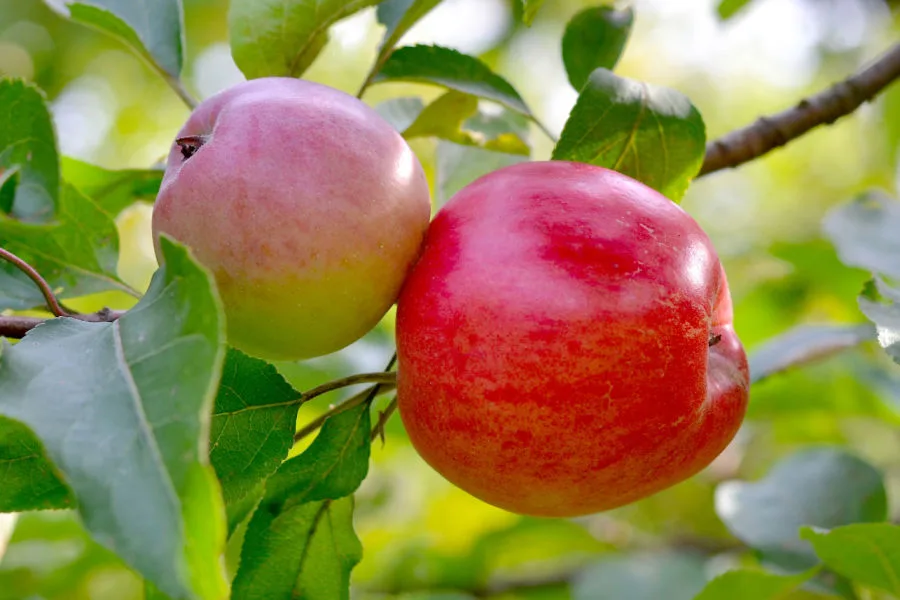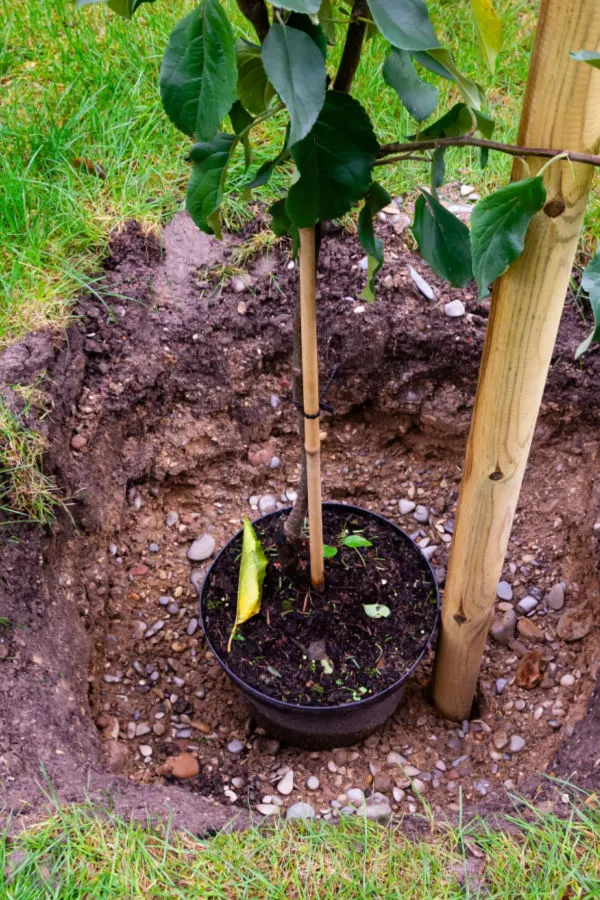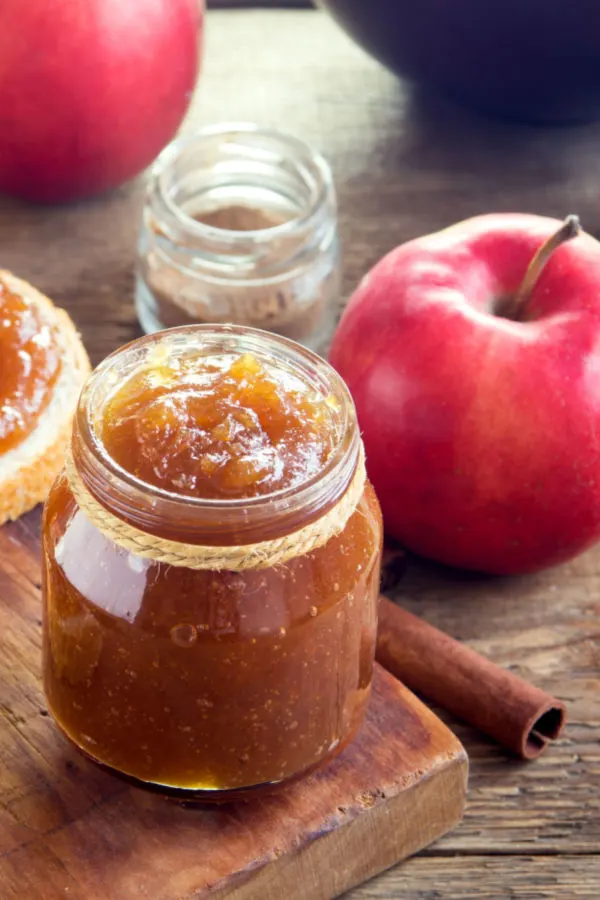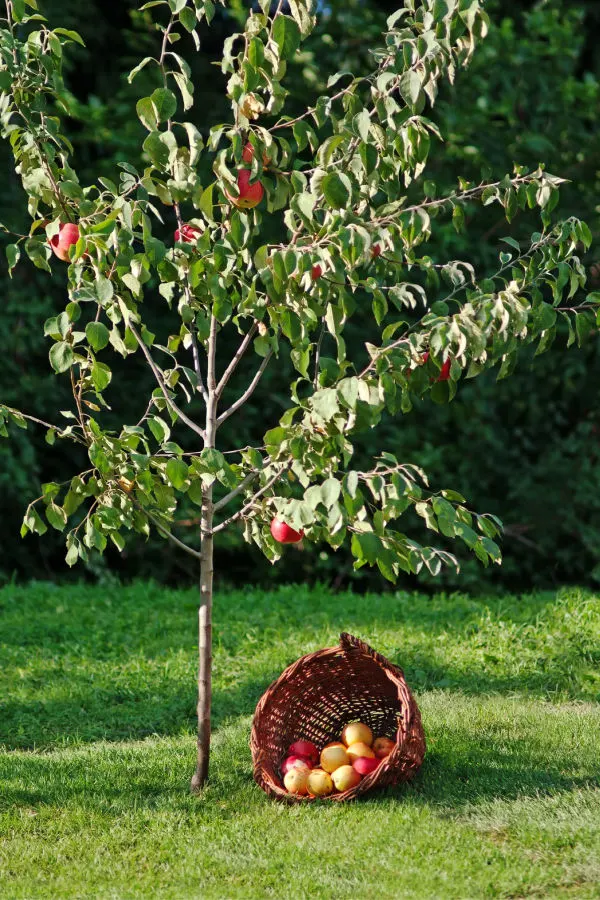If you have ever thought about planting and growing a few apple trees in your backyard, there is never a better time to do it than in the fall!
Although you can plant fruit trees into your landscape at any point of the growing season, fall truly is the ideal time to get them in the ground. In fact, when when it comes to planting nearly any tree, Autumn is almost always the best choice.
For one, the cooler temperatures are much less stressful on the trees. Fall planting allows just enough time for the roots of a tree to become established. The more favorable conditions help get them accustomed to the soil and prepares them for fast growth the following spring.

Fall planted trees also require far less watering than trees planted in the spring. After all, a spring planted tree will need more that its fair share of watering to help it through the hot summer months. But by planting in the early Autumn, an apple tree will have the benefit of going dormant for winter, and still having a cool spring to develop better roots before it has to handle its first “hot” summer.
The Perfect Perennial Crop – How To Plant Apple Trees In The Fall
There is something so satisfying about planting a few apple trees. For many homeowners, it is the ultimate symbol of putting down roots of a more permanent nature.
Apple trees are one of the best ways to grow a lasting source of delicious fruit. Let’s face it, for those who love to garden, nothing beats the harvest that a vegetable garden can bring each year. From fresh tomatoes, peppers, corn and more, a traditional garden can provide an amazing amount of food.
But one thing is for sure – it certainly takes a lot of work to plant a vegetable garden. Especially when you have to do that work over each and every year from start to finish.
From starting seeds, to planting, weeding, watering and harvesting, the hours of labor can pile up. And that is exactly where supplementing your food supply with a few low-maintenance apple trees can really come in handy!
Other than occasional pruning and fertilizing, apple trees require little in the way of yearly maintenance. And although planting a few apple trees can take a little bit of time and effort, the rewards can be long lasting.
A Lasting Harvest – How To Plant Apple Trees
Once an apple tree is in the ground and matures to the fruiting stage, it can provide twenty-five or more years of annual fruit. And all without having to plant and replant every year! And that annual harvest can make planting a few trees so worthwhile.
Apples not only taste great fresh, they store well too. In fact, many varieties can store for months in a cool, dark location without any need for refrigeration. And beyond fresh eating, there is of course apple pie (see our apple pie recipe), apple butter, apple crisp, apple strudel and a long list of magical dishes you can create from your own apple harvest!
With all of those benefits in mind, here is a look at how to plant a few trees of your own this year, and enjoy the fruits of your labor for years to come!
How To Plant Apple Trees
Selecting The Right Varieties – How To Plant Apple Trees
One of the most important secrets to growing apples successfully is selecting the right varieties to grow. Not only so they perform well in your particular climate zone, but also so your trees can have proper pollination.

For starters, make sure to select varieties that are hardy and tolerant to your growing zone. If not, you can be left with a tree that struggles to bear fruit, or worse, one that has difficulty surviving your climate. By picking varieties native to your area, you will always have the best chance for success.
Some Of Our Favorite Apple Varieties
Equally important when selecting your apple trees is to know how each tree is pollinated. Most apple trees require a second pollinator to insure that the trees will bear fruit. This is why planting one single tree is never a good idea.
For example, let’s say you like the Fuji apple variety. If you plant a single Fuji apple tree, you will be quite sad to find out you will never get to enjoy an apple from the tree. Why? Because the Fuji is a self sterile variety, and requires a second pollinator to fruit.
In order to have Fuji apples, you will also need to plant a partner tree, such as Gala or Granny Smith variety, both of which can help to pollinate the Fuji tree blossoms.
It may sound a bit daunting at first between selecting tolerant and partner friendly varieties, but almost all nurseries and on-line retailers have easy to read pollination charts. And of course, don’t be afraid to ask questions. Most nurseries worth their salt will have someone on staff that can guide you through the process with ease.
How To Plant An Apple Tree – Top Tips To Success!
Planting a fruit tree is actually a very simple process. Success really comes down to digging the hole large enough to allow the roots to expand, filling it with good soil, and making sure to provide proper water to help it establish in the soil.

Begin by digging your planting hole deep and wide. It should be two to three times the diameter and one and a half times the depth of the container. Once your hole is dug, mix back in equal amounts of compost and soil to the bottom of the hole.
Fill the bottom of the hole up so the top of the root ball sits about an inch above the top of the hole. At this point, water the root ball generously with a few gallons of water. Next, fill in around the rest of the hole with equal amounts of compost and soil.
With final planting, you will want the base of the trunk to be just above ground level. This will allow for good drainage and keep the tree from sitting down in water. Finish by applying a three to four inch layer of mulch.
Mulch is extremely important for helping the tree retain moisture and protect the root ball. Shredded hardwood mulch, straw, or shredded leaves all work well as a natural mulch.
Watering & Maintenance
For the first few weeks after planting, water your tree daily. This will keep the roots from drying out in the new soil and allow it to settle in. After a few weeks, cut back to watering a few times a week unless conditions are extremely hot and dry.
Once the tree is a few months old, you can cut back watering to weekly if no rain has fallen. For those who live in climates with a cold winter, water weekly until the ground freezes. For the first year, if no rain has fallen, weekly watering will continue to help your tree establish it’s young roots.
Here is to planting a few apple trees this fall, and to enjoying fresh apples for years to come! Happy Gardening – Jim and Mary.
Jim and Mary Competti have been writing gardening, DIY and recipe articles and books for over 15 years from their 46 acre Ohio farm. The two are frequent speakers on all things gardening and love to travel in their spare time.
As always, feel free to email us at thefarm@owgarden.com with comments, questions, or to simply say hello! You can sign up for our free email list in the subscribe now box in the middle of this article. Follow us on Facebook here : OWG Facebook. This article may contain affiliate links.


